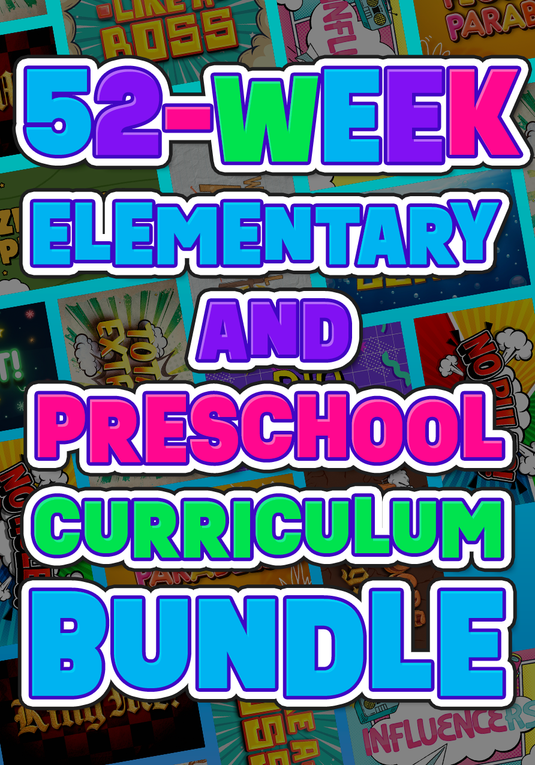Working and volunteering in children’s ministry is more than teaching and doing fun activities with the kids. It also involves classroom management. Realizing you’re responsible for handling behavior issues and keeping a structured environment can be overwhelming at times. The good news is, we aren’t doing this alone. God is with us. He knows our hearts and our desire to teach and lead these kids well. There is something very special about being called by God to love and serve others, and we can’t forget that HE is there guiding and helping us. Below are 10 classroom management tips for leading or aiding in your Sunday school class.
- Prepare your Heart
Preparation involves 3 main components. First, prepare your heart. Before you’re in the thick of it, with a classroom full of children, take some time to be alone with the Lord. Jesus was a great example of this. He spent a lot of time leading and teaching his disciples, but take notice of the many times in scripture that Jesus went off to spend time praying to God the Father. It’s only natural that when we are filled up, we have a more successful time in our ministry. We need God’s word and prayer time before we can teach others about Him.
- Prepare with a Good Curriculum
Secondly, be sure to have a good curriculum with engaging activities that fill the time frame, Bible-based lessons full of God’s truth, and age-appropriate material. It will be much more difficult to manage your class if you don’t have a curriculum that you can count on.
- Prepare for the Lesson
Read over the material ahead of time. Collect items you will need and prepare crafts or activities so there isn’t any time the kids are waiting around for you. When children don’t have anything to do, they are much more likely to misbehave. A well-prepared heart, lesson, and materials will free you up to give the children all of the attention they require.
- Engage
Engaging means to occupy the attention or efforts of the children you are serving. Let’s be honest, the activities you are doing need to be fun! A child who is not interested in what you are doing is much more likely to disrupt the class. Some ways to be more engaging are: to speak passionately and with excitement, to involve yourself in the activities with the children whenever appropriate, to add your creativity to the lessons, and to be present and not distracted. (Avoid your phone, leave personal problems at the door, etc.) Children are very aware and able to detect if you are engaged in the lesson with them. If you unintentionally send the message that it’s not a priority to you, children will often interpret that as— it isn’t important for them either. Making the children feel welcome is very important as well. Keep an eye out for new visitors and be sure to provide words of affirmation that they are welcome and you are glad they have come.
- Redirect
When a child is disruptive or behaves inappropriately, it falls on you to manage the classroom. How you handle this will set the tone for all of the other children in the class. Oftentimes, simply redirecting them back to positive behavior is enough. Remaining calm is key so that the kids see that the child’s effort to disrupt the class will not throw you for a loop. When you are calm, firm, and direct with what your expectations are, children won’t question your ability to lead. Some examples of redirection are: reminding the child what activity they are supposed to be participating in, providing a schedule that shows what is next so kids have something to look forward to, and asking if they need help with the task at hand. Sometimes children misbehave when they are discouraged or frustrated. Simply offering to help them or asking another student to give them a hand can reset their attitude and provide them with a support system.
- Give Positive Reinforcement
Kids need attention. When we show them that they are heard, seen, important, cared about, and respected, children will feel safe and more content. If we spend the majority of our time correcting poor behaviors, children will interpret that as a way to get your attention. Negative attention is still attention, and a child may crave attention no matter what kind. When you make an intentional effort to give positive reinforcement, kids will take this as a cue to work harder to be praiseworthy. Pay attention to good behaviors and make a point to acknowledge them. One thing to be careful of is taking this too far and ONLY paying attention to the kids who are going above and beyond to be good. Being sure to give all of the children your time and attention shows them that you care for each and every one of them.
- Give a Consequence
A consequence is necessary when a child attempts to harm others, or themselves, or damage property. Harm could be physical or emotional. This sets clear boundaries for children. Some examples of consequences are: speaking to the child about why the behavior is wrong and encouraging them to ask for forgiveness and return to the group, telling a child they are not allowed to participate in the next activity, asking a parent to speak with their child or remove them for the day. Try to be wise about how you handle consequences and remember that your goal is for the child to return to the group and make better choices. Only in extreme situations would having the kid removed from the class by a parent be recommended.
- Ask for Support
Having enough support is crucial to classroom management. The number of adults and kids in the classroom should be in ratio. For a large group, having one or two leaders and several assistants is ideal. For a small classroom with mixed-aged students, one teacher and one or two aids are helpful. Being honest with yourself and with your church about the support you need is key. Having the view that “I can handle it” or “I’ve had more kids than this” is often a detriment to you and your students. We are the body of Christ and “it takes a village” to do children’s ministry well.
- Transition Well
Transitioning from one activity to the next is often where you can lose the children’s attention. It is also a trigger for many special needs kids who may have a feeling of no control or confusion during transition time. 3 ways to manage this are:
- Have a schedule clearly posted for the children to see. Image icons are encouraged for children who can not read. Knowing what to expect next can help keep kids on task.
- Give verbal reminders of what is coming next before the activity is over.
- Provide structured transitions by clearly stating what is next, where the kids are to go, what leader they should follow, and fun creative ways to travel to the next place.
Some fun transition activities include playing following the leader, doing a quick gross-motor activity between stations, and giving kids jobs for the day such as line leader, caboose, or handing out papers. Be creative with transitions! They can be a lot of fun while still providing much-needed structure.
- Finish Strong
Your goal is to provide a fun and safe learning environment for the children that they will want to return to next week! At the end of the session, it is sometimes tempting to let the kids run wild while they wait for parent pick-up. Kids are ready for a less structured environment and you are too. You might even be ready for some of that “day of rest” time. But if you take this approach, accidents, misbehavior, and chaos are most likely to happen at the end of Sunday school hours. Finish strong with an engaging activity while children wait for parents to pick them up. In order for parents to see an accurate representation of what your classroom is like, you have to maintain structure all the way through to the end. Not only do we hope for the child’s desire to return the following week, but also the parents trust that we provide a good environment for them.
Classroom management can be a challenge at first, but with practice and consistency, there is much that can be achieved! If there is no classroom management, it is difficult to focus on anything but discipline. A structured environment is valuable for keeping kids safe, allowing space for learning, and ensuring that there is freedom for creativity and fun.




